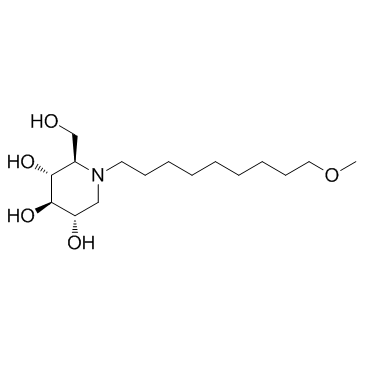| Description |
SP187 is a host-targeted iminosugar with activity against filovirus infections in vitro and in vivo. SP187 is active against influenza and dengue in vivo.
|
| Related Catalog |
|
| Target |
IC50: 29.97 μM (EBOV), 47.72 μM (MARV)[1]
|
| In Vitro |
The antiviral activity of iminosugar SP187 (UV-4) in vitro against EBOV and MARV is assessed using a yield-plaque assay format and the IC50 is determined. Antiviral activity for SP187 is observed with IC50 of 29.97 and 47.72 μM for EBOV and MARV, respectively[1].
|
| In Vivo |
The efficacy of SP187 (UV-4), the active free base component of UV-4B, and UV-5, the most potent iminosugar tested in vitro, is first assessed using a mouse model of EBOV infection. In this study, C57Bl/6 mice are administered 10 or 100 mg/kg of SP187 or UV-5 via oral gavage or IP injection. Dosing started ~1h before infection with ~1000 pfu of mouse-adapted EBOV and is repeated BID for 10 days at approximately 12 hour intervals for UV-5 or TID at approximately 8 hour intervals for SP187. The selected doses and schedule are based on tolerability studies in naïve mice. No efficacy is observed in the iminosugar treated mice as compared to the vehicle control[1].
|
| Cell Assay |
To test the activity of the iminosugars UV-1, UV-2, UV-3, SP187 (UV-4) and UV-5 against EBOV (Zaire-Kikwit) or MARV (Ci67), a yield-plaque assay is conducted in Vero cells. Multiple concentrations of compounds are incubated on 24-well plates of Vero cells for 1h at 8 concentrations (2 fold dilutions starting at 62.5 μM). After ~1h, pretreatment medium is aspirated and virus inoculums added (MOI of 0.1 with EBOV or MARV). After an additional hour of infection, virus inoculum is removed (no washing) and 1 mL of compound medium is added at the final concentration. After incubation for 72 hours, supernatants are harvested and competent viral particles released from the cells are enumerated by plaque assay in duplicate. Percent inhibition is determined by comparing DMSO-treated cells (average value) infected with virus to those treated with compound at the various concentrations. The IC50 are calculated using GraphPad Prism based on the % inhibition at each concentration[1].
|
| Animal Admin |
Mice[1] Mouseadapted EBOV and MARV-Ravn are used to infect female C57Bl/6 or BALB/c mice with target challenge dose of 1000 pfu via intraperitoneal injection. SP187 (free base) and UV-5 are prepared in acidified water for oral gavage (PO) or in phosphate buffered saline (PBS) for intraperitoneal infection (IP) and subcutaneous (SQ) delivery. SP187 (UV-4) or UV-5 are administered via PO, IP or SQ for 7-10 days starting 30-60 minutes before virus challenge at 5, 10, 20, or 100 mg/kg or vehicle only (water for PO or PBS for IP delivery). Compounds are administered either twice (BID) or three times (TID) daily at 12 or 8 hour intervals, respectively. Weights, morbidity and mortality are monitored for up to 21 days. Animals which displaye severe illness are euthanized based on predefined scoring systems.
|
| References |
[1]. Warfield KL, et al. Assessment of the potential for host-targeted iminosugars UV-4 and UV-5 activity against filovirus infections in vitro and in vivo. Antiviral Res. 2017 Feb;138:22-31.
|
